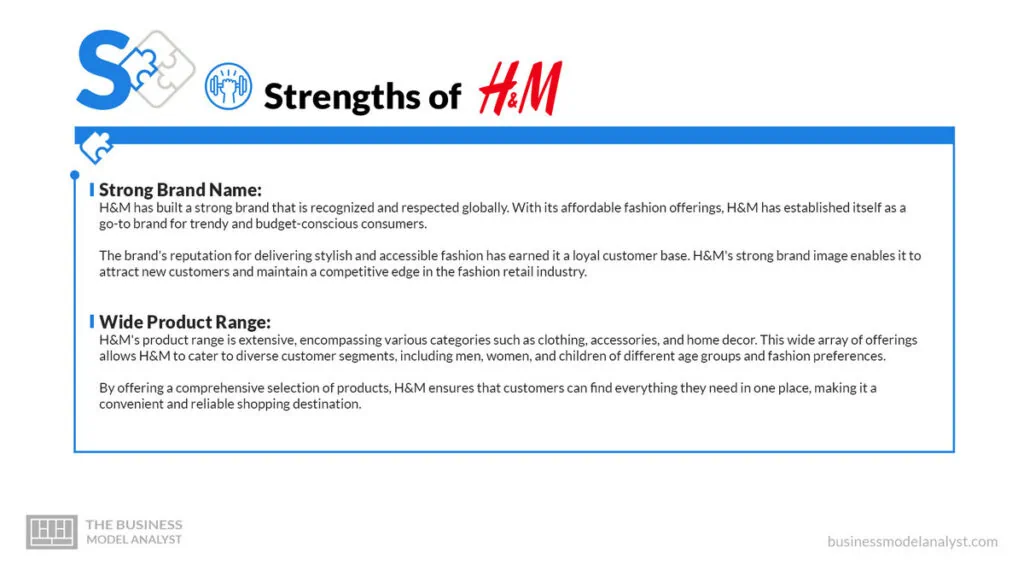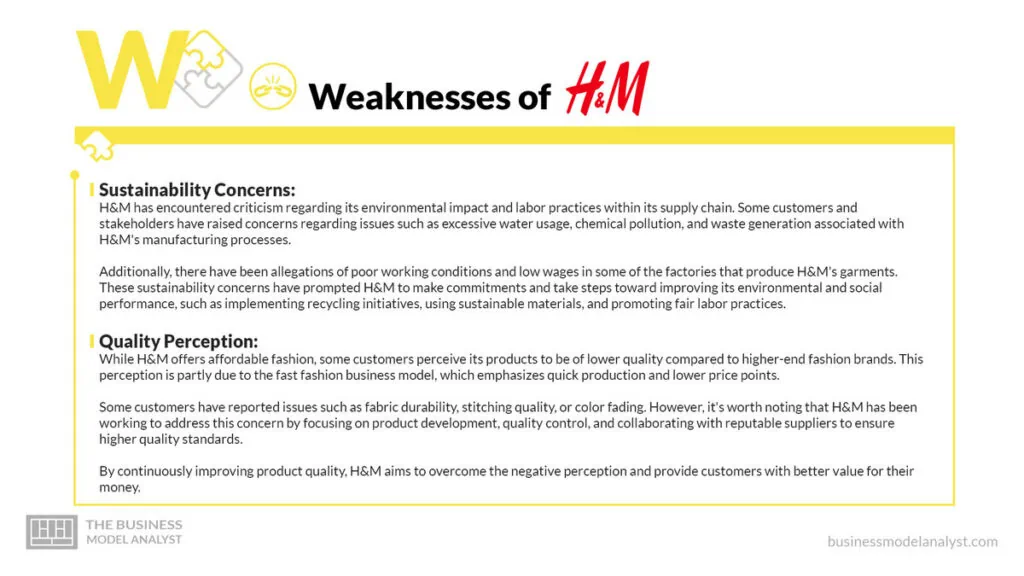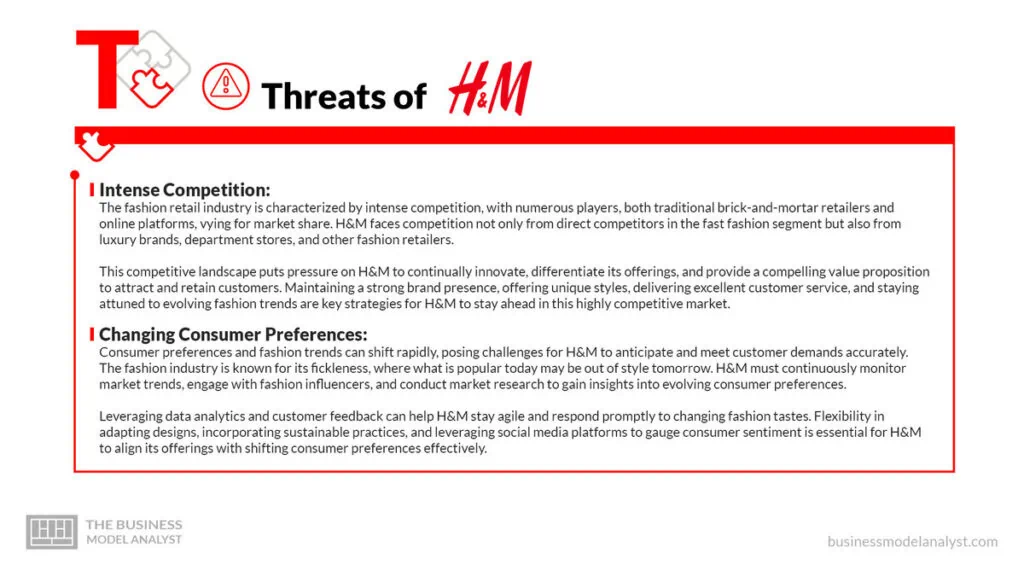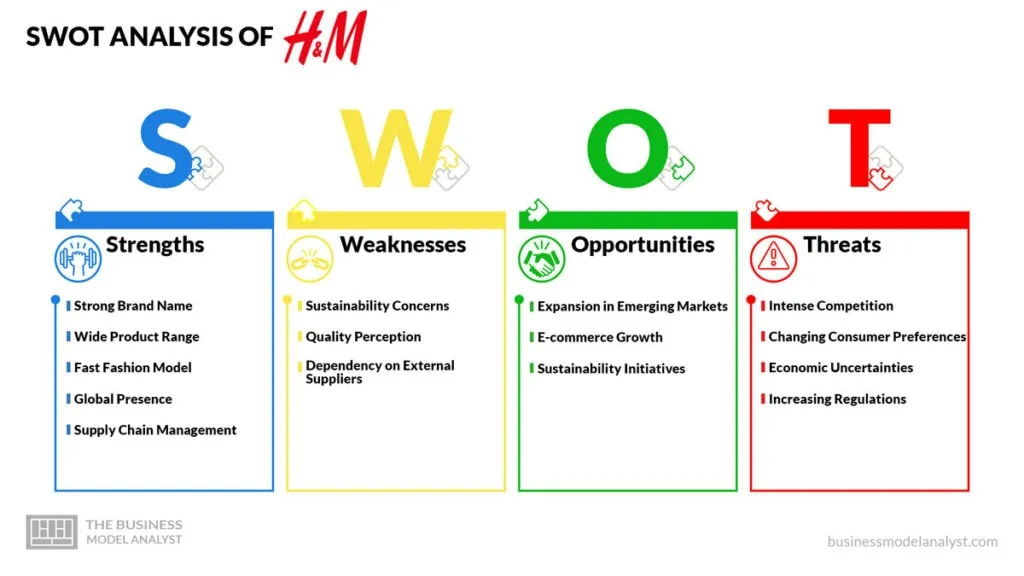H&M (Hennes & Mauritz) is a prominent global fashion retailer known for its affordable and trendy clothing offerings, so a look at the H&M SWOT Analysis can give us an idea of the secret behind the success of the brand.
H&M (Hennes & Mauritz) is a global fashion retailer known for its affordable and trendy clothing offerings. The company was founded in 1947 by Erling Persson in Västerås, Sweden. Initially, H&M focused on providing women’s clothing under the brand name “Hennes,” meaning “hers” in Swedish. In 1968, the company expanded by acquiring the hunting and fishing equipment store “Mauritz Widforss,” leading to the creation of the brand “Hennes & Mauritz” or H&M.
During the 1970s and 1980s, H&M experienced significant growth, opening stores in neighboring Scandinavian countries and later expanding into other European markets. The company’s success was driven by its focus on offering fashionable clothing at affordable prices, providing customers with a wide range of options to express their individual styles.
In the 1990s, H&M adopted a fast fashion business model, responding swiftly to changing fashion trends and bringing new collections to the market at a rapid pace. This approach propelled H&M’s expansion into international markets, including the United States and Asia, further solidifying its global presence.
H&M continued to innovate and adapt to evolving consumer preferences. In recent years, the company has placed a growing emphasis on sustainability and ethical practices. It launched several sustainability initiatives, such as the Garment Collection Program, aiming to promote recycling and reduce textile waste.
That being said, let’s take a look at the strengths, weaknesses, opportunities, and threats to the H&M business model.
Contents
H&M Strengths

Here are some of the competitive advantages of the H&M brand.
Strong Brand Name
H&M has built a strong brand that is recognized and respected globally. With its affordable fashion offerings, H&M has established itself as a go-to brand for trendy and budget-conscious consumers.
The brand’s reputation for delivering stylish and accessible fashion has earned it a loyal customer base. H&M’s strong brand image enables it to attract new customers and maintain a competitive edge in the fashion retail industry.
Wide Product Range
H&M’s product range is extensive, encompassing various categories such as clothing, accessories, and home decor. This wide array of offerings allows H&M to cater to diverse customer segments, including men, women, and children of different age groups and fashion preferences.
By offering a comprehensive selection of products, H&M ensures that customers can find everything they need in one place, making it a convenient and reliable shopping destination.
Fast Fashion Model
H&M has adopted a fast fashion model, which is characterized by quickly responding to the latest fashion trends and rapidly bringing new designs to the market. This approach enables H&M to stay ahead of competitors by swiftly adapting to evolving consumer preferences.
By minimizing lead times and efficiently managing its supply chain, H&M can introduce new collections and products regularly, keeping its offerings fresh and exciting for customers while still maintaining competitive prices.
Global Presence
With its extensive network of stores across numerous countries, H&M enjoys a significant global presence. This wide geographical reach provides H&M with access to a diverse customer base and allows the company to tap into different markets around the world.
By strategically expanding into new regions, H&M can capitalize on emerging fashion trends and consumer demands, while also mitigating risks associated with fluctuations in individual markets.
Supply Chain Management
H&M’s success is underpinned by its robust supply chain management system. The company has implemented efficient processes for production, distribution, and inventory management, ensuring timely delivery of products to its stores.
By maintaining strong relationships with suppliers and closely monitoring production and logistics, H&M can optimize its operations and minimize costs.
This streamlined supply chain allows H&M to meet customer demands promptly, adapt to market fluctuations, and effectively manage inventory levels to avoid overstock or shortages.
H&M Weaknesses

Here are some of the shortcomings of the H&M brand.
Sustainability Concerns
H&M has encountered criticism regarding its environmental impact and labor practices within its supply chain. Some customers and stakeholders have raised concerns regarding issues such as excessive water usage, chemical pollution, and waste generation associated with H&M’s manufacturing processes.
Additionally, there have been allegations of poor working conditions and low wages in some of the factories that produce H&M’s garments. These sustainability concerns have prompted H&M to make commitments and take steps toward improving its environmental and social performance, such as implementing recycling initiatives, using sustainable materials, and promoting fair labor practices.
Quality Perception
While H&M offers affordable fashion, some customers perceive its products to be of lower quality compared to higher-end fashion brands. This perception is partly due to the fast fashion business model, which emphasizes quick production and lower price points.
Some customers have reported issues such as fabric durability, stitching quality, or color fading. However, it’s worth noting that H&M has been working to address this concern by focusing on product development, quality control, and collaborating with reputable suppliers to ensure higher quality standards.
By continuously improving product quality, H&M aims to overcome the negative perception and provide customers with better value for their money.
Dependency on External Suppliers
H&M relies heavily on external suppliers for its products, which poses challenges in terms of quality control and supply chain disruptions. The company’s extensive supply chain involves sourcing materials and manufacturing garments from various suppliers worldwide.
This dependency exposes H&M to risks such as delays, capacity constraints, and potential quality issues arising from inconsistencies across suppliers. Furthermore, disruptions caused by natural disasters, political instability, or other unforeseen events can impact the supply chain, affecting product availability and customer satisfaction.
To mitigate these risks, H&M works closely with its suppliers, implementing strict standards and conducting audits to ensure compliance and maintain supply chain stability.
H&M Opportunities

Here are some opportunities the business can capitalize on.
Expansion in Emerging Markets
H&M has an opportunity to strategically expand its presence in emerging markets, particularly in countries experiencing a growing middle class and increasing disposable income. These markets present a vast customer base that is becoming increasingly interested in fashion and seeking affordable yet trendy options.
By carefully analyzing market trends, consumer preferences, and cultural nuances, H&M can tailor its product offerings and marketing strategies to effectively cater to these emerging markets. Additionally, entering emerging markets allows H&M to reduce its reliance on mature markets and diversify its revenue streams, mitigating risks associated with economic downturns in specific regions.
E-commerce Growth
The rapid growth of the online retail sector provides H&M with a significant opportunity to capitalize on this trend by strengthening its e-commerce capabilities. With the convenience and accessibility of online shopping, customers are increasingly turning to digital platforms to make their fashion purchases.
By enhancing its online presence, optimizing its website and mobile app, and offering seamless shopping experiences, H&M can reach a broader customer base beyond its physical stores. Effective online marketing, personalized recommendations, and user-friendly interfaces can further enhance customer engagement and drive sales.
Investing in logistics and fulfillment infrastructure will also ensure efficient order processing and timely delivery, enhancing customer satisfaction in the digital realm.
Sustainability Initiatives
Investing in sustainable practices presents H&M with the chance to appeal to environmentally conscious customers and differentiate itself in the market. As sustainability becomes a growing concern globally, consumers are actively seeking brands that prioritize ethical and environmentally friendly practices.
By adopting sustainable sourcing of materials, implementing recycling initiatives, reducing waste, and supporting fair labor practices, H&M can position itself as a responsible and socially conscious fashion retailer. Communicating its sustainability initiatives transparently to customers and stakeholders will build trust and loyalty, attracting a growing segment of environmentally aware consumers who are willing to support brands aligned with their values.
Additionally, embracing sustainability can also lead to cost savings in the long run through efficient resource utilization and improved supply chain management.
H&M Threats

Let’s take a look at some of the threats to the future survival of the company.
Intense Competition
The fashion retail industry is characterized by intense competition, with numerous players, both traditional brick-and-mortar retailers and online platforms, vying for market share. H&M faces competition not only from direct competitors in the fast fashion segment but also from luxury brands, department stores, and other fashion retailers.
This competitive landscape puts pressure on H&M to continually innovate, differentiate its offerings, and provide a compelling value proposition to attract and retain customers. Maintaining a strong brand presence, offering unique styles, delivering excellent customer service, and staying attuned to evolving fashion trends are key strategies for H&M to stay ahead in this highly competitive market.
Changing Consumer Preferences
Consumer preferences and fashion trends can shift rapidly, posing challenges for H&M to anticipate and meet customer demands accurately. The fashion industry is known for its fickleness, where what is popular today may be out of style tomorrow. H&M must continuously monitor market trends, engage with fashion influencers, and conduct market research to gain insights into evolving consumer preferences.
Leveraging data analytics and customer feedback can help H&M stay agile and respond promptly to changing fashion tastes. Flexibility in adapting designs, incorporating sustainable practices, and leveraging social media platforms to gauge consumer sentiment is essential for H&M to align its offerings with shifting consumer preferences effectively.
Economic Uncertainties
The fashion industry is susceptible to economic fluctuations and downturns, which can significantly impact consumer spending on discretionary items like fashion. During economic recessions or periods of low consumer confidence, individuals may reduce their fashion-related expenditures, leading to a decline in sales and profitability for H&M.
Economic uncertainties, such as inflation, unemployment rates, or global economic conditions, can affect consumer purchasing power and overall demand for fashion products. To mitigate these risks, H&M needs to maintain a diversified product portfolio, manage pricing strategies effectively, and adapt its marketing efforts to cater to changing consumer behaviors during different economic conditions.
Increasing Regulations
The fashion industry is facing a rise in regulations concerning labor standards, environmental sustainability, and supply chain transparency. Governments, non-governmental organizations, and consumers are increasingly demanding greater accountability and ethical practices from fashion brands.
H&M must navigate through these regulatory challenges by ensuring compliance with labor laws, implementing sustainable sourcing and manufacturing practices, and promoting supply chain transparency. Adhering to these regulations can require significant investments in monitoring and auditing processes, as well as supplier engagement.
By proactively addressing these regulatory concerns, H&M can mitigate reputational risks, strengthen its brand image, and demonstrate its commitment to ethical and sustainable business practices.
Conclusion
In conclusion, H&M has established itself as a prominent global fashion retailer with a strong brand name, wide product range, fast fashion model, global presence, and efficient supply chain management. These strengths have contributed to the company’s success and competitive advantage in the fashion retail industry.
However, H&M also faces challenges and weaknesses, including sustainability concerns, quality perception issues, dependency on external suppliers, intense competition, changing consumer preferences, economic uncertainties, and increasing regulations.
To thrive in the future, H&M must capitalize on opportunities such as expanding in emerging markets, leveraging e-commerce growth, and investing in sustainability initiatives. Additionally, the company needs to address its weaknesses by improving sustainability practices, enhancing product quality, and diversifying supplier sources.
By effectively navigating these factors, H&M can continue to meet customer demands, drive innovation, and maintain its position as a leading fashion retailer in the global market.


